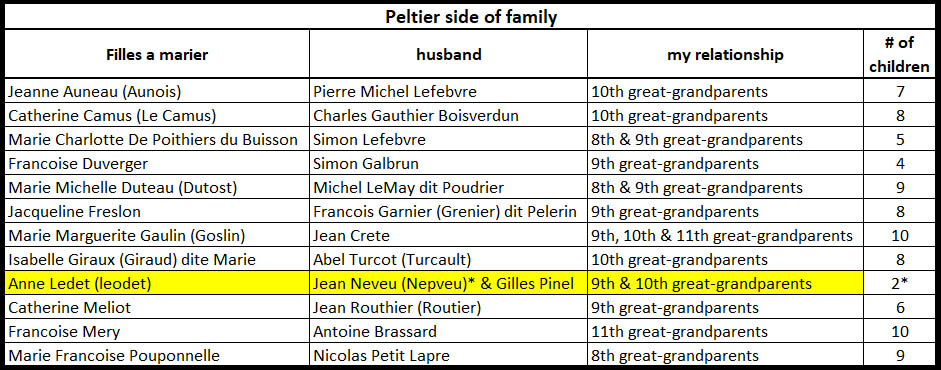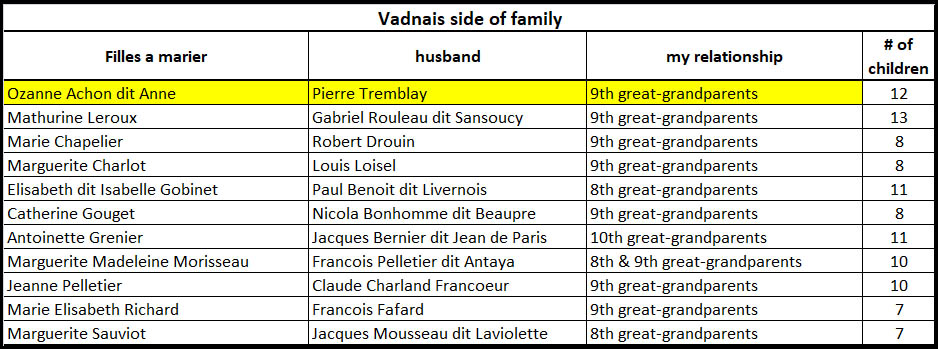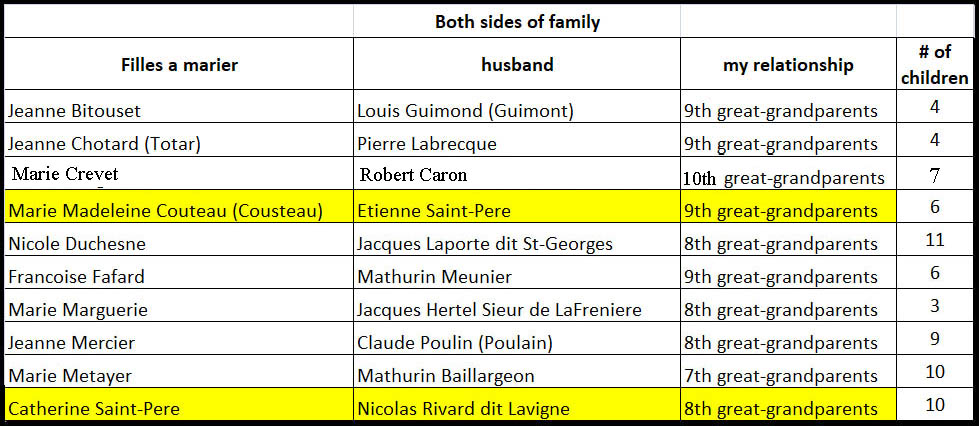Filles a Marier (Marriageable girls)
Before the “filles du roi,” King’s daughters, there were 262 women known as “filles a marier,” or marriageable girls, who emigrated from France to New France (Canada) between 1634 and 1662. They comprised a quarter of all women who arrived under the French regime. Unlike the King’s daughters these women came on their own or in small groups, often unaccompanied. Once in New France most of the girls were cared for and housed by the Ursulines (an order of nuns) until they married.
During this period of time almost 80% of the population in New France was male. These men were recruited and contracted based on their skills. They went to New France on behalf of the King to take advantage of the vast resources the land and sea offered and to explore and claim new land for the crown. There were also soldiers from the Carignan regiment who went to New France to protect those already there from the constant attacks from the natives. For the most part these men did not intend to settle there. However, at some point in time because of the economics in continually bringing ships of men over, along with taking those back that wished to return, it was decided that it would be better to attempt to keep the men in New Canada by bringing marriageable French women over that the men could marry, have a family with and as a result grow the colony on its own without the need for any more migration from France.
Only healthy, strong women were recruited to go and live in New France. To start, they were at sea for at least 6 weeks suffering under terrible living conditions: generally about 10% of the people died before reaching New France. Upon arrival they were met with wilderness they had never experienced and in not so many months winter like they had never seen. There was the constant threat of attacks by the native populations and diseases that they did not know how to deal with, let alone cure (After reading some of the accounts of viruses and other maladies they suffered through, I am thankful for the world we live in now and our ability to get vaccinated against these outbreaks.). It does not sound like paradise to me.
So why even consider going to New France? The simple answer was that they were seeking a better life, which speaks volumes considering the ocean voyage and the unknown that awaited them in New France. In France these women did not have the freedom that New France offered. At that time in France all marriages were arranged. If your family was unable to provide you with a dowry you would either marry below your station, become a nun (if you were Catholic), or become a servant. On the other hand, marriage was almost certainly assured a marriageable girl in New France. Because of the huge gender imbalance she could choose the man she wanted to marry. These young women held quite a bit of power that they would have never experienced had they stayed in France.
The 262 filles a marier all met the following criteria:
- Must have arrived before September 1663.
- Must have come over at a marriageable age (12-45 years old).
- Must have married or signed a marriage contract at least once in New France or have signed an enlistment contract.
- Must not have been accompanied by both parents.
- Must not have been accompanied by or joining a husband.
Facts about filles a marier:
- Their average age was 22.
- 57% were from rural areas; 43% from urban areas.
- 20.6% were related to previous immigrants.
- 62% settled in Quebec, 23% in Montreal, 15% in Trois-Rivieres.
- 9.5% were widows.
- They had an average of 6.7 children.
Many branches of our ancestry include these founding mothers of Canada. Currently in the families of Vadnais and Peltier I count 34 filles a marier that are direct ancestors. The following tables give more information about them.



I’ve highlighted couples in each table. All of our filles a marier have interesting stories that I will tell you about in due time, but those that are highlighted have additional connections:
- The marriage of Anne Ledet and Jean Neveu produced one of my 8th great-grandmothers and her second marriage with Gilles Pinel produced an 8th and 9th great-grandmother.
- Ozanne Achon and Pierre Trembley left a huge legacy. Currently 13% of all Quebeckers are named Trembley with it being the third most common surname in all of Canada behind Smith and Brown. There are over 9000 Trembley families in North America. The Trembleys are also the largest French speaking (Francophone) family in North America.
- The last two couples I highlighted are all related. Marie Madeleine Couteau married Etienne Saint-Pere in France and had 6 children. Catherine Saint-Pere was one of those children. After Etienne died, Marie Madeleine emigrated from France to Canada with her children and not only did Marie Madeleine remarry, but her daughter Catherine also married. I did not list Marie Madeleine’s second husband Emery Calteau or her third husband Claude Houssard dit Le Petit in the table because we are not direct descendants of either of them. Both of these women meet the criteria to be considered filles a marier.
If you’d like to know more about the filles a marier, Sandra Goodwin of Maple Stars and Stripes interviewed Peter J. Gagne about the filles a marier. You can read the show notes and listen to the podcast at this link: https://maplestarsandstripes.com/shownotes/mss-069-filles-marier/
My husband Steve jokes that our family tree is a trunk with no branches. I look at these few ancestors listed in this post, along with the corresponding relationships, and it makes me think that maybe he is not so far off in his assessment. None the less I prefer to lean in the direction of our family tree having branches; they are just very tightly interwoven.
Thanks for visiting, come back soon,
Cynthia
© 2022 Copyright by Cynthia Vadnais, All Rights Reserved
Filles a Marier (Marriageable girls) Read More »
